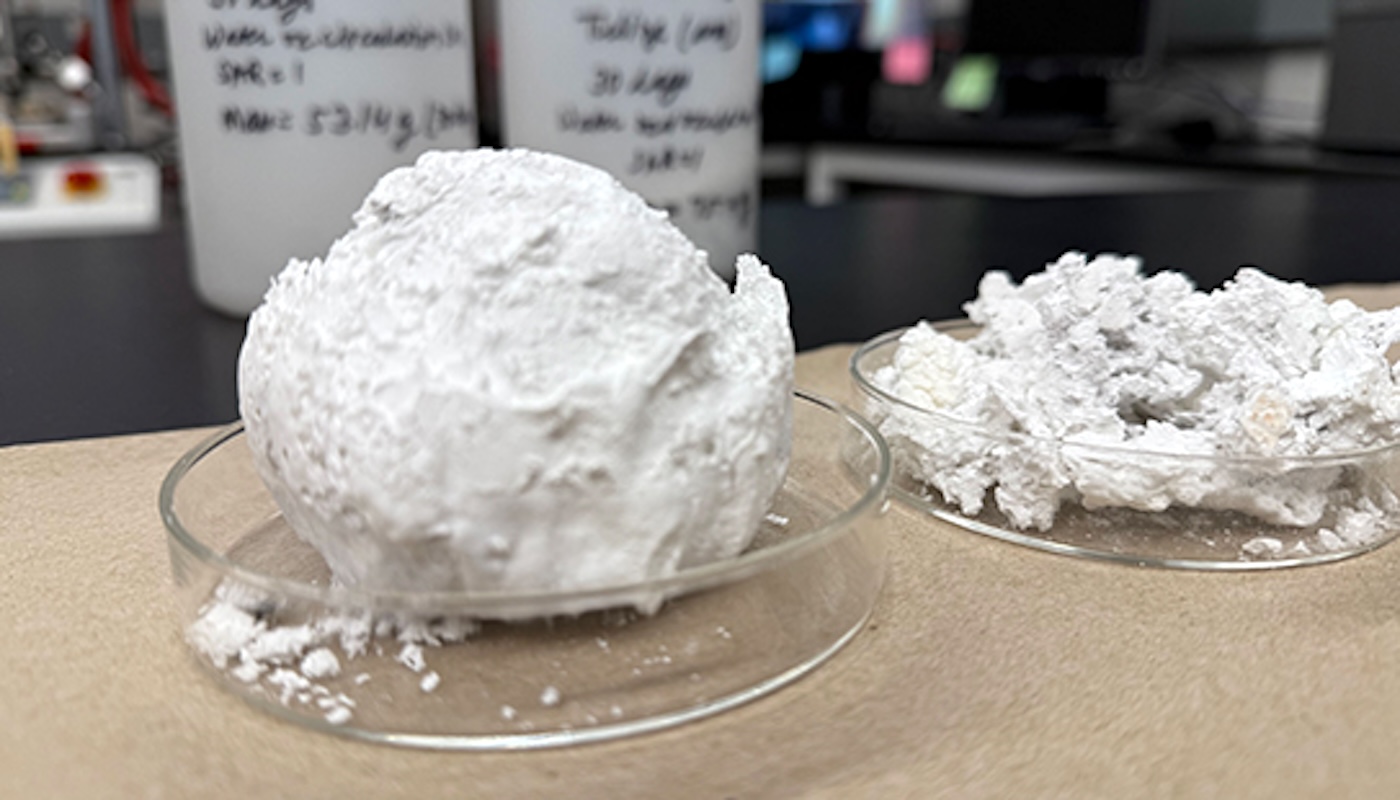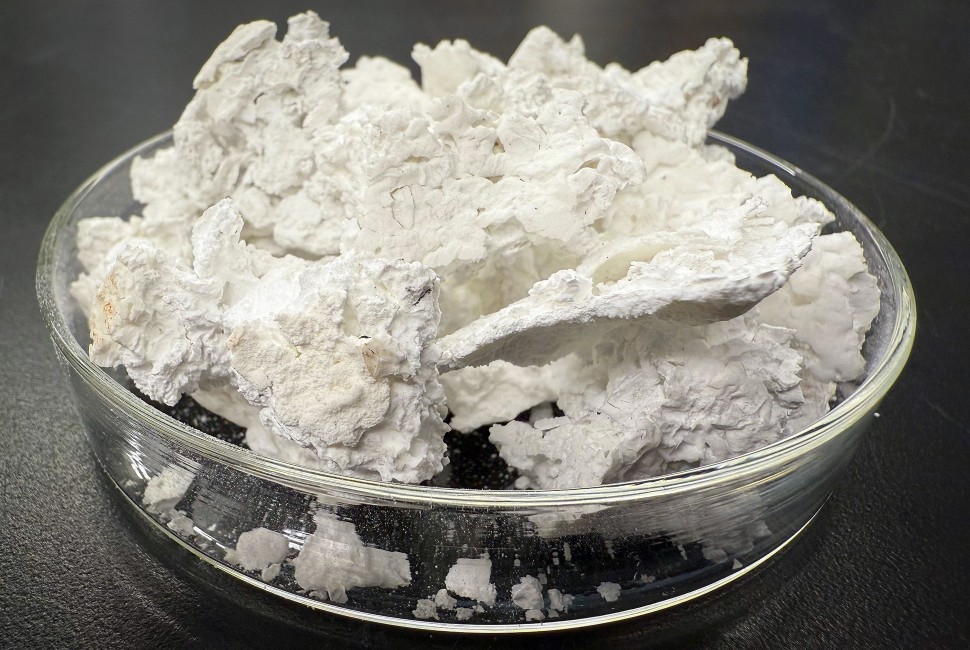
A new path for concrete, with seawater and science
Concrete's dirty secret is out. Depending on who you ask, it accounts for 5% to 10% of the world’s carbon emissions. But a team of researchers at Northwestern University says it doesn’t have to be that way — and they’ve come up with a radical solution.
Working with global building materials company Cemex, the Northwestern Engineering team has developed carbon-negative concrete. Not just "less bad" — actually carbon-removing. And they’re not stopping with just concrete. This same approach could change how we make cement, paint, and plasters.
>> RELATED: Demand For Low-Carbon Cement Is On The Rise

Carbon-negative materials; via Northwestern University.
What makes this tech different?
Unlike traditional cement-making, which releases huge amounts of CO2, the new process developed by Dr. Alessandro Rotta Loria and his team flips the script.
“We have developed a new approach that allows us to use seawater to create carbon-negative construction materials,” said Dr. Alessandro Rotta Loria, PhD, a faculty member at Northwestern.
Instead of mining for raw sand, the team grows sand-like minerals in seawater, using CO2 and electricity. They insert electrodes into seawater and apply a low electrical current. That current splits water into hydrogen gas and hydroxide ions, and when CO2 is bubbled in, the reaction creates calcium carbonate and magnesium hydroxide — both solids.
The result? Materials that behave like concrete but lock away CO2 — potentially for centuries.
Concrete made like coral?
The scientists say their process mimics how corals and mollusks form shells. But instead of relying on biology, the system uses electricity to jump-start mineral formation.
The outcome is a sustainable and scalable way to build — without the carbon baggage.
“The appeal of such an approach is the attention that is being given to the ecosystem and using science to harness the elements in the contemporary environment to develop valuable products for several industries and preserve resources,” said Davide Zampini, vice president of global R&D at Cemex.
That’s a big statement coming from a company responsible for massive volumes of traditional cement production.

Carbon-negative material forming around electrodes
>> In Other News: Innovating the Future: Gautam Swami's Global Journey in Low-carbon Energy and Finance
A partnership grounded in science and scale
The real power of this development lies in who’s backing it. Cemex, a global leader in ready-mix concrete, isn’t just watching from the sidelines. They’re collaborating with Northwestern to make this tech practical and ready for commercial use.
This means the innovation won’t just sit in a lab journal. It could end up in real-world buildings, roads, and infrastructure sooner than we think.
And with Cemex recently named one of the world’s most ethical companies, the timing aligns with its public push for more sustainable materials.
Why sand matters too
What might surprise many is how big of an issue sand mining has become. It’s been quietly wreaking havoc on riverbeds, coasts, and ocean floors around the world. By making a synthetic alternative using seawater and CO2, the new method also offers a fix for a less-publicized environmental crisis.
One top comment on the announcement sums it up well:“Solving two problems with one solution is fantastic.”
Bigger than concrete
While the focus has been on concrete, the potential reach of this technology is broader. The same process could apply to paint, plasters, and even new kinds of carbon-storing construction materials. That means entire buildings could one day serve as carbon sinks, not just shelters.
This builds on earlier work from Dr. Rotta Loria’s lab, which found a way to store CO2 in concrete long-term, without compromising its strength.
That’s key for mass adoption — no one wants to sacrifice performance for sustainability, especially in construction.
What's next?
With proven lab results and an eager commercial partner, all eyes are on the next steps. Scaling this innovation will require investment, new supply chains, and regulatory approvals.
But the urgency is real. Just lowering emissions won’t be enough anymore. As climate change accelerates, the goal is shifting to removing carbon from the atmosphere.
This kind of material could help tip the scales — not just stop the damage, but actually reverse it.
A meaningful step forward
For years, climate solutions have circled around cutting emissions. But we’re past that stage now. We need ways to pull carbon out of the atmosphere, and this Northwestern-Cemex collaboration is a step in that direction.
It’s not just about fixing concrete. It’s about fixing what concrete represents: the foundation of modern life, and, potentially, a tool for healing the planet.
And if we can build cities that remove carbon instead of adding it? That’s a blueprint worth following.
Subscribe to the newsletter
Daily decarbonization data and news delivered to your inbox
Follow the money flow of climate, technology, and energy investments to uncover new opportunities and jobs.
Latest issues
-
This U.S. Plant Might Change Aviation Forever
In This Issue 🛫 A Georgia Plant Just Cracked Aviation's Fuel Puzzle 📉 CO2RE And ERM Release 2025 Update On Greenhouse Gas Removal Costs 🔗 Abatable Partners With BlueLayer To Streamline Corporate C...
-
Canada Just Made CCUS Way More Profitable
Inside This Issue 💼 Canada Unlocks EOR for Federal Tax Credits in Landmark Policy Shift 🚀 Carbontech Funding Opens as CDR Sector Pushes for Net-Zero Standard Revisions 💧 CHARBONE Confirms its Firs...
-
The $13.6B Oilfield Deal That's Actually About Clean Energy
Inside This Issue 💼 The $13.6B Oilfield Deal That's Actually About Clean Energy 💸 Waga Energy Signs a $180M Debt Financing to Accelerate Its Expansion in the US 🌫️ Deep Sky Launches Operations of ...
Company Announcements
-
Plug Executive Leadership To Participate In Investor Conferences In New York City
SLINGERLANDS, N.Y., Dec. 03, 2025 (GLOBE NEWSWIRE) -- Plug Power Inc. (NASDAQ: PLUG), a global leader in comprehensive hydrogen solutions for the hydrogen economy, announce its participation in two...
-
NEW ORLEANS, Dec. 3, 2025 /PRNewswire/ -- Newlab New Orleans ("Newlab") and Japan's largest power generation company JERA Co., Inc. ("JERA"), have entered into a strategic partnership through JERA ...
-
Combination Integrates Carbon-Credit Origination Expertise With U.S.-Produced, Lower-Cost Carbon-Negative Fuels To Meet Growing Global Demand Southern Energy Renewables secures a $402 million bond...
-
Abatable Partners With BlueLayer To Streamline Corporate Carbon Credit Procurement
Abatable is partnering with BlueLayer, the end-to-end operating system designed specifically for carbon project developers, to revolutionise how carbon project developers share information with buy...